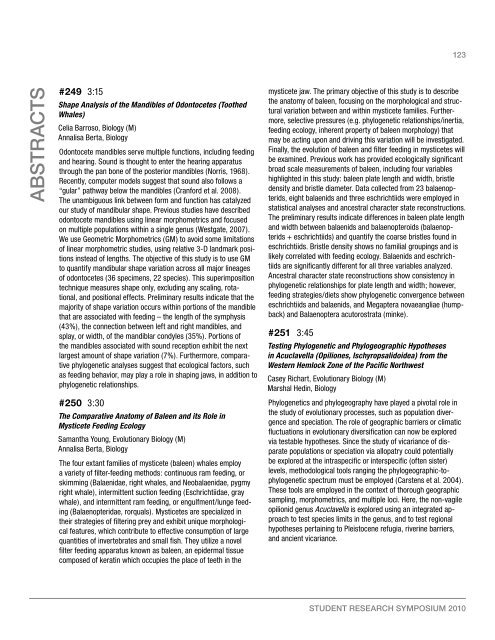STUDENT RESEaRch SympoSiUm 2010 - Graduate and Research ...
STUDENT RESEaRch SympoSiUm 2010 - Graduate and Research ...
STUDENT RESEaRch SympoSiUm 2010 - Graduate and Research ...
You also want an ePaper? Increase the reach of your titles
YUMPU automatically turns print PDFs into web optimized ePapers that Google loves.
AbstrActs<br />
#249 3:15<br />
Shape Analysis of the M<strong>and</strong>ibles of Odontocetes (Toothed<br />
Whales)<br />
Celia Barroso, Biology (M)<br />
Annalisa Berta, Biology<br />
Odontocete m<strong>and</strong>ibles serve multiple functions, including feeding<br />
<strong>and</strong> hearing. Sound is thought to enter the hearing apparatus<br />
through the pan bone of the posterior m<strong>and</strong>ibles (Norris, 1968).<br />
Recently, computer models suggest that sound also follows a<br />
“gular” pathway below the m<strong>and</strong>ibles (Cranford et al. 2008).<br />
The unambiguous link between form <strong>and</strong> function has catalyzed<br />
our study of m<strong>and</strong>ibular shape. Previous studies have described<br />
odontocete m<strong>and</strong>ibles using linear morphometrics <strong>and</strong> focused<br />
on multiple populations within a single genus (Westgate, 2007).<br />
We use Geometric Morphometrics (GM) to avoid some limitations<br />
of linear morphometric studies, using relative 3-D l<strong>and</strong>mark positions<br />
instead of lengths. The objective of this study is to use GM<br />
to quantify m<strong>and</strong>ibular shape variation across all major lineages<br />
of odontocetes (36 specimens, 22 species). This superimposition<br />
technique measures shape only, excluding any scaling, rotational,<br />
<strong>and</strong> positional effects. Preliminary results indicate that the<br />
majority of shape variation occurs within portions of the m<strong>and</strong>ible<br />
that are associated with feeding – the length of the symphysis<br />
(43%), the connection between left <strong>and</strong> right m<strong>and</strong>ibles, <strong>and</strong><br />
splay, or width, of the m<strong>and</strong>iblar condyles (35%). Portions of<br />
the m<strong>and</strong>ibles associated with sound reception exhibit the next<br />
largest amount of shape variation (7%). Furthermore, comparative<br />
phylogenetic analyses suggest that ecological factors, such<br />
as feeding behavior, may play a role in shaping jaws, in addition to<br />
phylogenetic relationships.<br />
#250 3:30<br />
The Comparative Anatomy of Baleen <strong>and</strong> its Role in<br />
Mysticete Feeding Ecology<br />
Samantha Young, Evolutionary Biology (M)<br />
Annalisa Berta, Biology<br />
The four extant families of mysticete (baleen) whales employ<br />
a variety of filter-feeding methods: continuous ram feeding, or<br />
skimming (Balaenidae, right whales, <strong>and</strong> Neobalaenidae, pygmy<br />
right whale), intermittent suction feeding (Eschrichtiidae, gray<br />
whale), <strong>and</strong> intermittent ram feeding, or engulfment/lunge feeding<br />
(Balaenopteridae, rorquals). Mysticetes are specialized in<br />
their strategies of filtering prey <strong>and</strong> exhibit unique morphological<br />
features, which contribute to effective consumption of large<br />
quantities of invertebrates <strong>and</strong> small fish. They utilize a novel<br />
filter feeding apparatus known as baleen, an epidermal tissue<br />
composed of keratin which occupies the place of teeth in the<br />
123<br />
mysticete jaw. The primary objective of this study is to describe<br />
the anatomy of baleen, focusing on the morphological <strong>and</strong> structural<br />
variation between <strong>and</strong> within mysticete families. Furthermore,<br />
selective pressures (e.g. phylogenetic relationships/inertia,<br />
feeding ecology, inherent property of baleen morphology) that<br />
may be acting upon <strong>and</strong> driving this variation will be investigated.<br />
Finally, the evolution of baleen <strong>and</strong> filter feeding in mysticetes will<br />
be examined. Previous work has provided ecologically significant<br />
broad scale measurements of baleen, including four variables<br />
highlighted in this study: baleen plate length <strong>and</strong> width, bristle<br />
density <strong>and</strong> bristle diameter. Data collected from 23 balaenopterids,<br />
eight balaenids <strong>and</strong> three eschrichtiids were employed in<br />
statistical analyses <strong>and</strong> ancestral character state reconstructions.<br />
The preliminary results indicate differences in baleen plate length<br />
<strong>and</strong> width between balaenids <strong>and</strong> balaenopteroids (balaenopterids<br />
+ eschrichtiids) <strong>and</strong> quantify the coarse bristles found in<br />
eschrichtiids. Bristle density shows no familial groupings <strong>and</strong> is<br />
likely correlated with feeding ecology. Balaenids <strong>and</strong> eschrichtiids<br />
are significantly different for all three variables analyzed.<br />
Ancestral character state reconstructions show consistency in<br />
phylogenetic relationships for plate length <strong>and</strong> width; however,<br />
feeding strategies/diets show phylogenetic convergence between<br />
eschrichtiids <strong>and</strong> balaenids, <strong>and</strong> Megaptera novaeangliae (humpback)<br />
<strong>and</strong> Balaenoptera acutorostrata (minke).<br />
#251 3:45<br />
Testing Phylogenetic <strong>and</strong> Phylogeographic Hypotheses<br />
in Acuclavella (Opiliones, Ischyropsalidoidea) from the<br />
Western Hemlock Zone of the Pacific Northwest<br />
Casey Richart, Evolutionary Biology (M)<br />
Marshal Hedin, Biology<br />
Phylogenetics <strong>and</strong> phylogeography have played a pivotal role in<br />
the study of evolutionary processes, such as population divergence<br />
<strong>and</strong> speciation. The role of geographic barriers or climatic<br />
fluctuations in evolutionary diversification can now be explored<br />
via testable hypotheses. Since the study of vicariance of disparate<br />
populations or speciation via allopatry could potentially<br />
be explored at the intraspecific or interspecific (often sister)<br />
levels, methodological tools ranging the phylogeographic-tophylogenetic<br />
spectrum must be employed (Carstens et al. 2004).<br />
These tools are employed in the context of thorough geographic<br />
sampling, morphometrics, <strong>and</strong> multiple loci. Here, the non-vagile<br />
opilionid genus Acuclavella is explored using an integrated approach<br />
to test species limits in the genus, <strong>and</strong> to test regional<br />
hypotheses pertaining to Pleistocene refugia, riverine barriers,<br />
<strong>and</strong> ancient vicariance.<br />
<strong>STUDENT</strong> RESEARCH SYMPOSIUM <strong>2010</strong>


